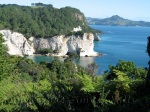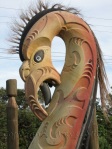On my dad’s side of the family, camping was a big deal. In fact, I referred to my paternal grandparents for years as Camping Grandma and Camping Grandpa. Camping took different forms for different generations. The honored ancestors traveled in style with a popup camper, and eventually they graduated to an RV. The indoor digs were especially great as it meant Grandma could make us animal-shaped pancakes! Dad’s style involved a canvas tent, sleeping bags, a cooler and the Coleman stove. We generally jumped into the car and headed out on the open road for a few weeks, staying in National Forests along the way. There was a LOT of driving on these trips. I’ve seen pretty much most of the National Parks and Forests in the western United States, as a result. Played all the car games invented. Created some new ones with my brother. Oh, and had some colossal car fights with said sibling, followed by the Angry Hand seeking retribution and silence. You know what I’m talking about if the phrase “Don’t make me stop this car” strikes fear into your heart. The good times included getting to try ALL the sodas made by Cragmont. We always had two of each flavor, and this was the only time we got to have most of them. And I especially remember my mom keeping me entertained at some forest campground, by showing me how to make “fairy circles” out of flowers and stones. Chuck has been expanding my repertoire of camping experiences. We’ve been snow camping, on a cross-country ski trip around the rim of Crater Lake. (Did you know that you don’t need a flashlight to go pee, when you’re snow camping? At least, not if the moon’s out. The snow is bright enough.) We did some “free camping” around Scotland, although NOT on the island of Iona. There is NO camping on Iona. It took us until almost midnight to figure out where to sleep when we didn’t believe the tourist office on that one. And now, we’ve experience Kiwi camping.
Kiwi camping is… well, posh. Now, to be fair, I don’t mean those hardy New Zealanders who are following in Sir Ed‘s lofty footsteps. There are some hardcore campers here, as there are anywhere that mountain climbers and adrenaline junkies congregate. No, I’m talking about family camping at the local holiday park. We discovered this phenomenon a year or so ago, when we decided on a whim to go out to the Coromandel Peninsula for a few days after New Year’s. This is a finger of land that sticks up east of Auckland. During holiday weekends and summer vacations, the Big City empties out as family vehicles queue on their way to Coromandel beaches. Little did we know that we were lucky just to get a camping spot, at this time of year. We booked a space at the Hahei Holiday Resort, an impressive low-cost lodging mecca which features not only slots for tents and room for RVs, but also a vast assortment of cottages, cabins, villas and even a backpackers (that’s Kiwi for “youth hostel”). Not to mention that it is a literal hop-skip-and-a-jump from the white-sand Hahei Beach
.
As we pulled in, we noticed that the camp sites resembled enormous parking spaces. Yes, they were all in rows, so you’d be within easy distance of your neighbor. More noticeable were the tents. Or should I say canvas palaces? Imagine those old canvas tents with hollow metal poles and peaked tops, which I associate with car camping of my childhood. Back in the early 1980s, our family tent was beige and green and perhaps 9 feet by 12 feet. Now, triple or quadruple that. Add a room-sized awning and perhaps a separate canopy (in Kiwi: a marquee) for eating under. Don’t forget a stove, a small TV, lawn chairs, picnic tables, and a full complement of pots and pans from home. Oh, and possibly a gas-run fridge. Yes, some people bring REFRIGERATORS to go camping. Funny thing? There are shared kitchens which have their own fridges and electric stoves onsite. So, I guess it just didn’t do to walk all the way over there for another beer? To be fair, these are the families that plan to be there for two weeks minimum. Unlike the inland American tradition of the family roadtrip, many New Zealanders look forward to the holidays so they can go to the beach and relax for sun-soaked days on end. Bouts of sunbathing, socialising, and barbecues are interrupted every few days for a trip “into town” for provisions. (Invariably, this means that the grocery stores in these places are packed with sun-dazed holidaymakers, wandering around distractedly.) Not that the holiday park is in the bush. Just that villages like Hahei swell to 10 times their size when the vacation crowd is around.
As we pulled in, our well-established neighbors to the left were asking our right-hand neighbors whether they wanted some help setting up their mid-sized tent and outbuildings. That father veritably snarled his negative response. So, when we started pulling out our gear, the jocular gentleman joked that he and his buddies were going to just sit back and watch us get set up. Chuck told me to go read a book, when I offered to help. Five minutes later, the tent was up. The beer-happy neighbor asked Chuck whether our two person pup-tent was where the dog was sleeping? Where was the rest of the gear? Chuck almost got the book thrown at him, when he responded with a similar jest about who WAS sleeping in the tent. Families come back to the same place for years, even decades. We learned about this tradition from these Hahei neighbors. We were invited over for a beer and ended up partaking in an evening feast for at least 10 family, friends and neighbors. This family had been coming to the same place for the last 18 years, usually getting the same exact campsite. They book the spot a year in advance and know almost all their neighbors. We got our spot because someone left early. They couldn’t believe that we were only staying one night. After all, they were there for about three weeks of the summer + Christmas holiday. I began to understand what Kiwis mean when they say they’re “going to the beach” for Christmas. They definitely mean more than a BBQ on the sand. It’s more like going to camp, except the whole family comes along. I suspect my Bulgarian and Romanian friends will be able to relate, with their August holidays on the Black Sea. Indeed, there is a long tradition of New Zealanders repairing to the seaside for a relaxing time. They even have a special Kiwi term for the family cabin — it’s call a bach. And it’s Kiwi as meat pies.
Our trip to the Coromandel almost converted me to this style of sedentary seaside vacation. We visited nearby Hot Water Beach, where you dig your own hottub when the tide is low enough that thermal springs seep up through the sands. That time, the tide was starting to come in, so we didn’t get to build a tub, but we were able to sit in the warm sand and feel the water, while our legs were being buffeted by the cool surf. Chuck was okay with this because he had just stepped into a sink hole where the hot water was bubbling straight up to the surface. He got in up to his knee, which meant the water was SUPER hot down there near his foot. I don’t think I’ve ever seen him move so fast! He jumped out of there and ran out to the cold surf to cool off. He was lucky not to be scalded. On another trip, I did get to both sunbathe and soak simultaneously. A friend from the Northwest was exultant at being able to work on his tan in mid-March! Hahei Beach itself is a wonderful place to walk on the gentle white-sand beach, either day or night. Chuck and I noticed triboluminescent sea creatures fluorescing in the surf under a starry sky. And I’ve also witnessed a stupendous sunrise on that beach. Up the road is Te-Whanganui-a-Hei Marine Reserve, which features white stone cliffs and aquamarine waters. Several bays feature limpid waters, making snorkeling a popular pasttime. It’s both mesmerizing and eerie to swim through waving forests of seaweed, staring at fish and sea snails and sea anenomes. It felt like coming out of a dream whenever I raised put my head above water.
Since our little jaunt to Coromandel, we’ve discovered that holiday parks are indeed the way to go. Especially if you’re living on a budget and really just need a place to crash. If a sleeping bag isn’t your style, the cabins can be cozy, too. Nevertheless, we have not been converted to the luxury of Kiwi camping nor to the settled home-away-from-home holiday. There’s just too much to see and too many experiences to have, for me to want to stay in one place every vacation. Indeed, isn’t the point of camping to get away from so-called civilization? Perhaps my favorite memory from New Zealand will be camping in Fiordland National Park on a tumultous rainy night, with thunder echoing up and down the hundreds of glacier-etched canyons around us. The glow of the lupins at dusk, the pounding of nearby waterfalls, the sound of rain on the silver beech trees, and the sense of easy satisfaction from having a warm meal and dry clothes on. These are what camping offers best. Nevertheless, our camping Kiwi neighbors have taught me that nothing beats a healthy, home-cooked meal eaten outside at a picnic table in beautiful surroundings. Because, when the weather is nice in New Zealand, you don’t really need fancy digs. You just need the great Kiwi outdoors.
Come along to the Coromandel: NZ – Coromandel by jocuteca.
























